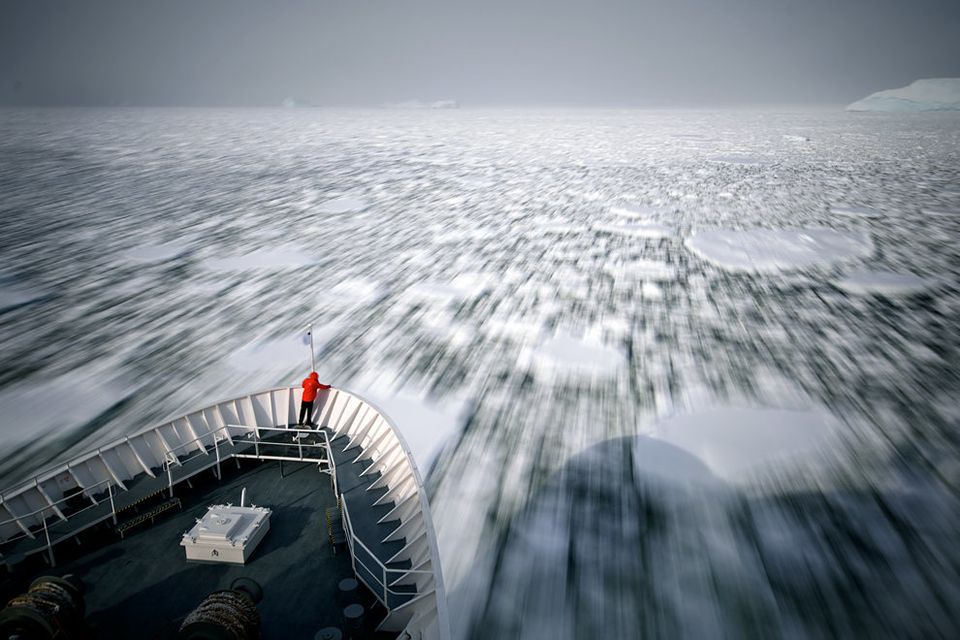Each of the following stunning photos has been featured in National Geographic’s “Extreme Photo of the Week” series this year. Armchair adventurers, rejoice!
Climbing During a Blizzard in Rocky Mountain National Park
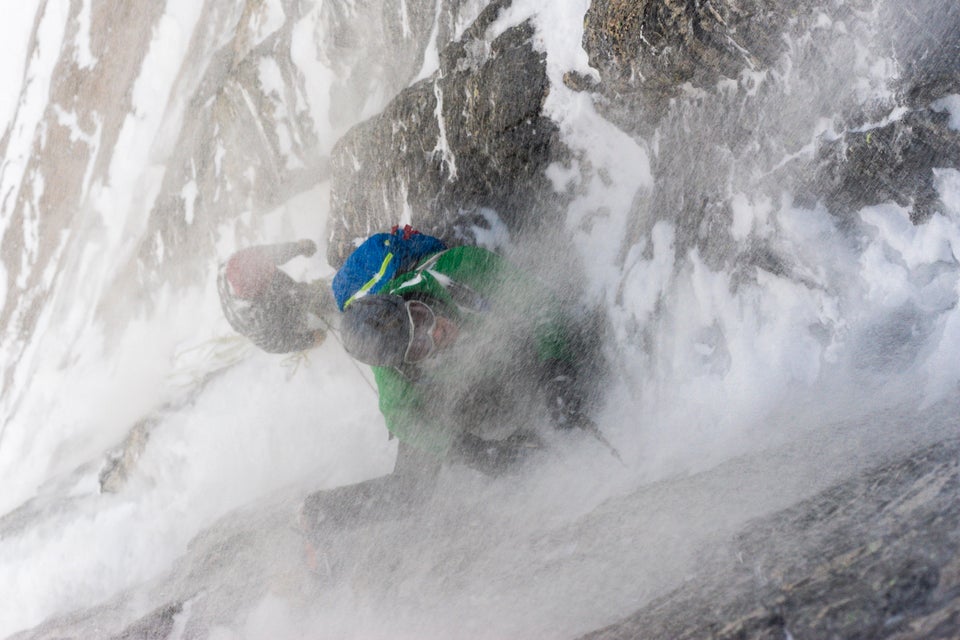
Photograph by John Dickey
“The conditions were some of the worst I have ever shot in,” says photographer John Dickey, who took this image of climbers Bruce Miller, in front, and Kevin Cooper on Mount Meeker in Colorado's Rocky Mountain National Park. “The spindrift was constant and so heavy at times that it was difficult to breathe,” he says. Dickey is no neophyte when it comes to shooting in winter conditions: He is currently working on a film about the evolution of winter climbing in the park and the environment’s role in the sport. But even this seasoned photographer was getting scared. “It seemed as if a costly mistake was inevitable,” he remembers. “I could have never expected conditions to get that bad [in November], and had to slow things down to be as clear and deliberate as possible. "Fortunately," Dickey says, “everyone stayed on their toes and the climbers were rock solid. We made our way up and out slowly but surely.”
Record-Setting Paragliding Traverse of the Alaska Range
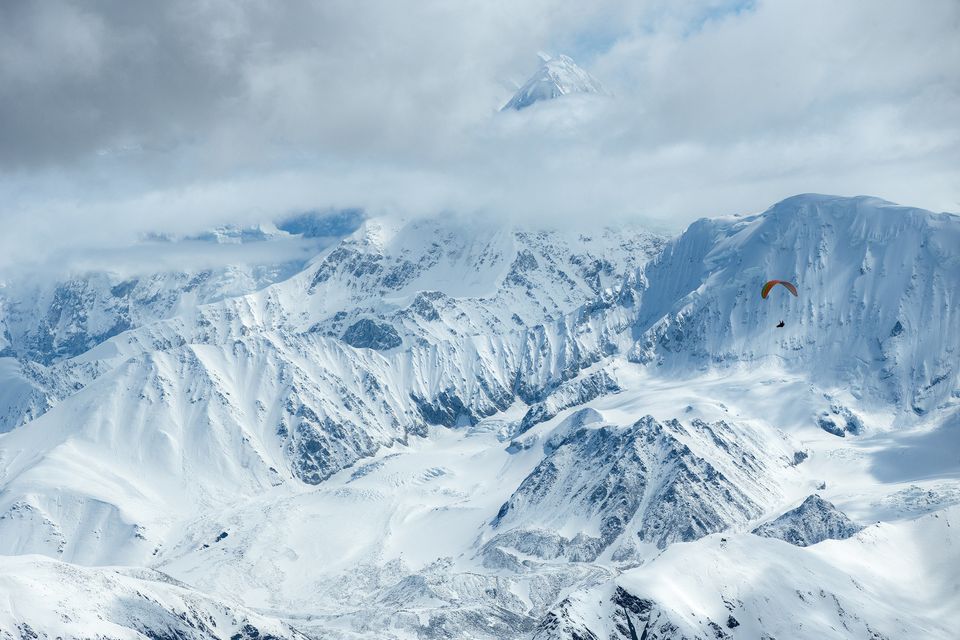
Photograph by Jody MacDonald
“I was incredibly focused on flying well, as we needed to stay in the air and make distance,” says Gavin McClurg, pictured here during the first ever traverse of the Alaska Range by foot and paraglider. “This had been a dream of mine for six years—to fly across the most remote and iconic mountains in North America.” The attempt didn’t start out well, however. Bad weather kept McClurg and his expedition partner, Dave Turner, pinned down in their tents for more than a week before being able to get airborne. But finally, “some of the clouds cleared and I had a perfect view of Denali, the highest mountain in North America,” he says. “I felt like we were pulling off something completely absurd and really special, and not likely to be repeated for a long time. In short, I was totally blown away.” Photographer Jody MacDonald, who shot this image of McClurg flying past Mount Foraker and Mount Denali, about 37 miles into his 124-mile route over Denali National Park, was just as excited. “There was a lot of pressure for them to fly as far as they could through the park,” she says, because they weren’t allowed to land or take off anywhere inside the park. “The clouds were developing more and more by the minute, but they were able to fly around the clouds against an unbelievable background.” MacDonald says that McClurg’s dream of making the traverse was the result of careful planning and ambition. “There have been only two other documented traverses: one by foot, and one by foot and pack raft. Paragliding in the Alaska Range had never been done, and traversing the entire range, from one extreme end to the other, was pretty audacious.” About halfway through the expedition, Turner and an accompanying film crew departed, leaving McClurg completely alone and facing miles of bushwhacking through dangerous terrain toward his goal. “The closest call during this section was crossing the Gakona River, which comes out of the Gakona Glacier. I had to forge 10 miles upriver along the banks, following a grizzly trail, because the river was much too deep and fast to cross on foot,” he says. Eventually he crossed via an ice bridge, “but the footing, due to the hard ice and talus, was treacherous. One slip and I would have plummeted several hundred feet into the icy river and had very little chance of survival.” Thirty-seven days after launching his attempt, McClurg completed the traverse without any serious injuries. “His vision and determination to make this happen and suffer it out was amazing to witness,” MacDonald says. McClurg adds: “Even on the really physical or scary days, life was so wonderfully simple. You wake up, you eat and have coffee, and then your whole job for the day is just to stay alive.”
Photographing Surfers From Under the Waves at Teahupoo, Tahiti
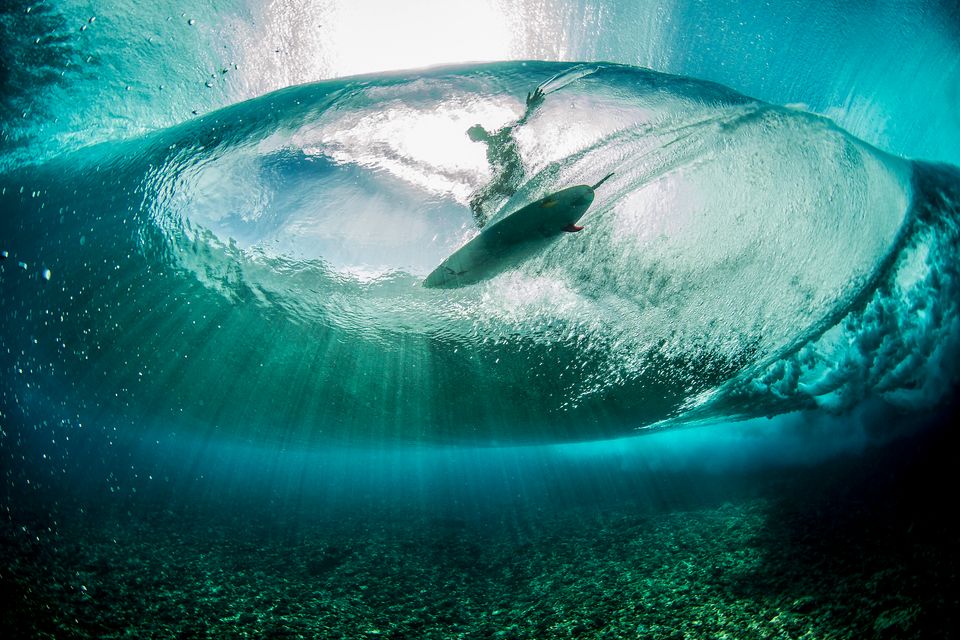
Photograph by Ben Thouard
“The surface of the ocean was like perfect glass, and was perfect for shooting underwater,” says photographer Ben Thouard of his image of surfer Landon McNamara riding a wave in Teahupoo, Tahiti. “I had been trying to get this shot for some time without much success. When I saw the wave coming, I dove under and turned back to look from behind the wave. The sun was coming from right through the lip of the wave, and I knew that I wanted to catch the surfer coming through the light,” he says. Factors beyond his control came together to make the picture work, he says. “It’s not often that I get impeccable water clarity, no wind, good waves, and light all in one frame. The result ended up being pretty amazing!” Thouard adds that, after spending his entire day underwater and shooting from below the surface, he had no idea who the surfer in this shot was. “I didn’t have time to check the pictures until I got home,” he says. “But thanks to social media, a year later, I was able to identify Landon in the photo.”
Advertisement
Bouldering in the Buttermilks, California
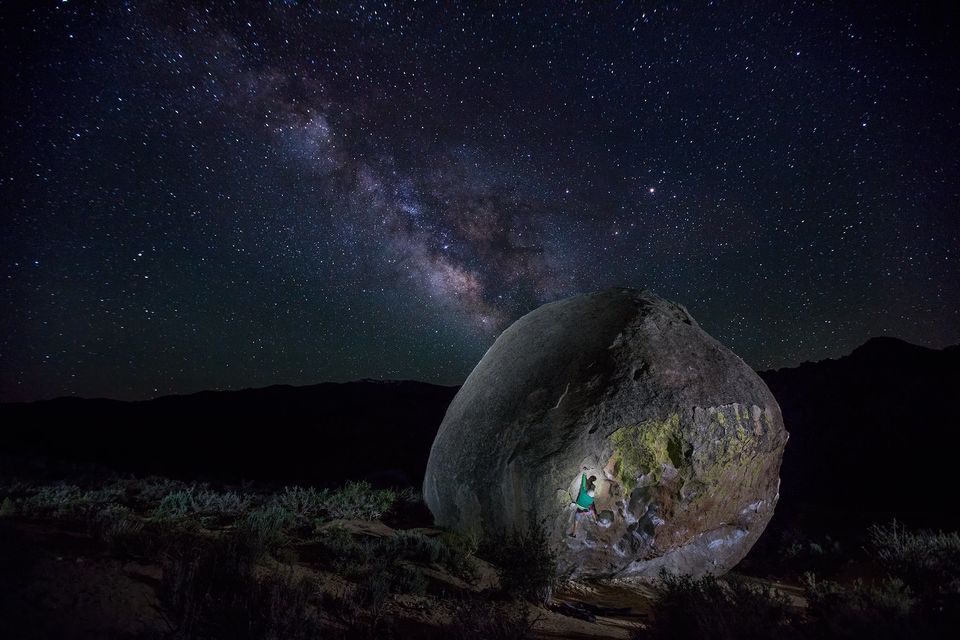
Photograph by Fred Pompermayer
“I had no idea what to expect from this experience,” says rock climber Eduardo Carvalho of this nighttime image by his friend, photographer Fred Pompermayer. It was shot under the Milky Way at the Buttermilks in Bishop, California. The two chose a line with solid holds on the Grandma Peabody boulder so Carvalho could hang on when the Milky Way hit its highest point in the sky at 3:20 a.m. “All I could think was to stay as still as possible, knowing how important this was to get the image he had in mind,” Carvalho says. Nailing this image was a team effort, Pompermayer says. “As a photographer, I am constantly coming up with ideas to produce inspiring and exciting images. It can be hard to find people that are excited about your vision and want to help make it happen. Not everyone is willing to wake up in the middle of the night to go bouldering, and then sit tight for a 13-second exposure over and over again.” After the first few test shots, Pompermayer recalls, “everyone got superstoked with the results, and it kept improving until we got the perfect lighting.” Carvalho says the thing he loves most about climbing, besides working in beautiful places, is “the physical and mental challenges that allow me to grow and gain strength—and sharing these experiences with friends.”
Wakeskating on a Remote Lake in Slovakia

Photograph by Jan Kasl
“It was a little crazy wakeskating this gap—it was about a 12-foot gap with a 10-foot hole down to where Jan was taking the photo,” says professional wakeskater Ben Horan about this shot by photographer Jan Kasl. “I definitely didn’t want to end up down there at 21 miles per hour!” Horan pulled a varial flip over the large concrete hole at a remote lake in Slovakia while Kasl stood in ankle-deep mud to get the impressive angle. “Once the winch was set, guys started pulling huge tricks over the hole. It was late afternoon and light conditions were pretty good, but not from the inside of the hole. So I added one flash right above my head, which lit the rider and the slimy algae that covered the walls,” Kasl says. Horan, Kasl, and the rest of their team had spent 10 days traveling around the Czech Republic and Slovakia searching out great shots across the countryside. They found this locale on the last day of the trip. “I was already pretty happy with all the photos I had made so far, but we decided to check one more location, and that was where we found this amazing place,” Kasl says. Horan says he would love to winch more untouched spots like this one. “There is something about being on a board where your feet are not attached, and you have the freedom to shove the board around and do tricks.”
Kayaking Over Spirit Falls in Washington State
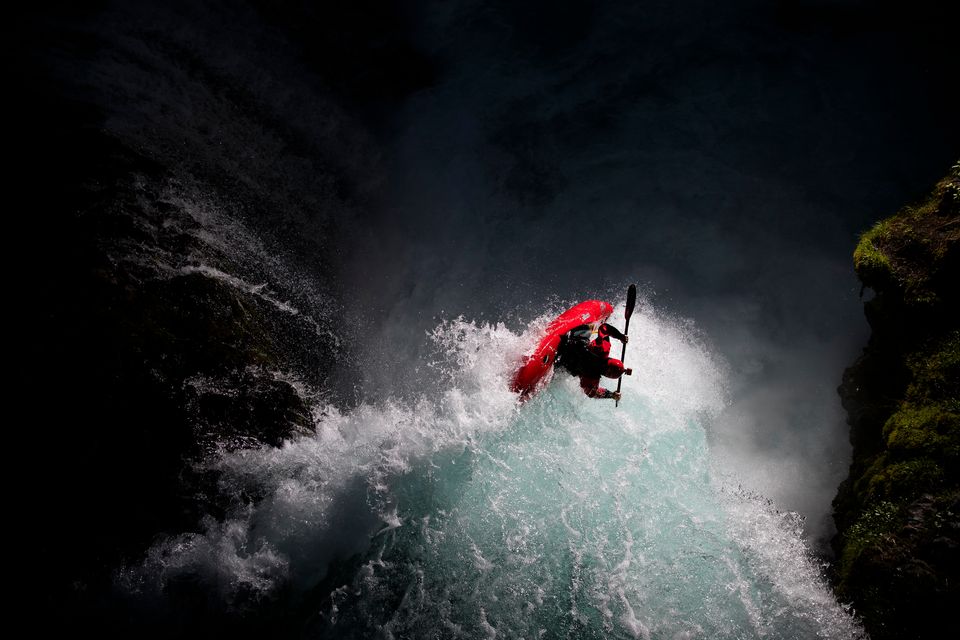
Photograph by Krystle Wright
“I swear my index finger was sweating from nerves,” says photographer Krystle Wright of this photograph, which she took using a drone with two flashes connected to it, of kayaker Rush Sturges as he dropped off Spirit Falls in White Salmon, Washington. “But when Rush came over the falls and rolled the kayak, I knew as soon as I pressed the shutter that I had nailed an awesome shot and something that was different [from] anything that I've tried in the past.” The shoot at Spirit Falls was intended to be a test run before trying the same setup later at Hamma Hamma Falls, but this “pure experiment” was all Wright needed. “Turns out, I [got] the shot on the first evening. Perhaps having the mind-set of no pressure allowed me to be more relaxed and allow the shot to happen,” she says. Even in her mellow state of mind, Wright was all business. “I had challenged myself to nail each run in one shot so that I could keep the ISO down as much as possible. It's an interesting challenge to take away the high frame rate and really choose my moment, rather than spraying shots and hoping for the best." As a photographer and artist, I want and need to be challenged so that I can continue to evolve and try new things even if it means trying something new and failing,” she adds. “Thankfully, this time around, I was able to come out with a successful photo.”
Advertisement
Kayaking at Night in the Canadian Rockies

Photograph by Paul Zizka
“Working alone and out in remote locations is always time-consuming, and it involves a lot of back and forth to get the shot,” says Paul Zizka of this self-portrait he took in a kayak on Goat Lake in the Canadian Rockies. “I had been planning on visiting this location for some time, and on this night the conditions were perfect. The stars danced across the surface of the lake, and it felt like I was gliding through the night sky.” Shooting a self-portrait at night isn’t without its challenges, Zizka says. Keeping yourself still enough in a kayak so the camera can catch a sharp exposure is particularly daunting. “I propped the kayak on top of a rock to help stabilize it once I was in the frame. It took a few tries, but eventually I got a frame with sharp focus that I could be happy with.”
Kayaking Over Celestial Falls, White River, Oregon

Photograph by Tyler Roemer
“With most action photography, I feel that I only have a couple chances to make the photo work to tell the story,” says photographer Tyler Roemer, who took this mid-winter photo of kayaker Christie G. Eastman preparing to paddle off Celestial Falls on the White River in Oregon. “With the roaring of the water, communication between Christie, the other boaters, and me was down to nothing. To get in position, I perched on a ledge that was directly across from the falls’ line of sight. Access was easy for me, but more challenging for the kayakers,” Roemer says. Eastman, meanwhile, was warming up in the pool above the falls and lining up her kayak with the spout of the waterfall to ensure a clean plunge. “It can be difficult to see from upstream,” she says. Eastman was able to execute the icy maneuver, but the drop-off by another member of Roemer’s team didn’t go as planned. That boater “misread the water slightly, which sent him into an over-rotation and an improper landing. He injured his arm, and he had to eject out of his boat to swim to the safety of the shore,” Roemer says. Despite the small setback, Roemer calls the trip a success. “I love being witness to scenes that unfold in front of the lens like this, especially when everyone walks away with a smile on their face.”
More from National Geographic:
